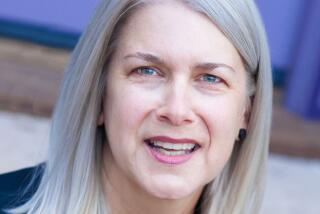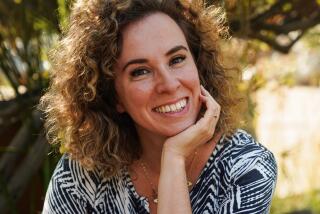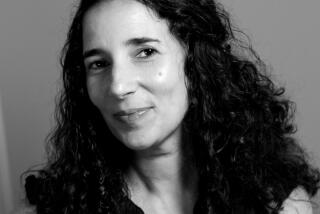Author Hope Edelman’s ‘journey of faith’
“Motherless Daughters,” “Motherless Mothers,” “Mother of My Mother,” “Letters From Motherless Daughters”: These four books have earned Hope Edelman the title of Mommy Guru. Driving to her home in Topanga Canyon, one has every right (and plenty of time) to entertain conceptions of the Earth Mother, the Motherless Earth Mother.
Edelman’s new book “The Possibility of Everything” (Ballantine Books: 352 pp., $25) already has the mommy blogs exceeding available bandwidth. How to put this delicately: It is a memoir of a strange time in her life. In 2000, when her daughter Maya was 3, Edelman became convinced that Maya was inhabited by an evil spirit. She and her husband, Uzi, took Maya to a bush doctor and then a well-known shaman in Belize to have the spirit evicted from their daughter’s body.
You want to know what happened? It worked.
That’s the short version of Edelman’s carefully crafted, highly detailed memoir, written almost 10 years after the family came home to Topanga, minus Dodo, Maya’s imaginary friend/evil spirit.
The woman who answers the door of a house perched high at the top of Topanga does not look like an earth mother. In fact, she looks rather businesslike; extremely well-organized and composed. The house does not give off hippie vibes. There is, however, a loud chorus of crickets -- live food, Edelman tells me, for the family’s pet tarantula.
So how did she find herself in the world of bush doctors, evil spirits and shamans? “I felt lost as a new parent,” Edelman recalls. “I didn’t feel things were solid and dependable.”
She and her husband had been in Topanga for only a few years. Every major appliance in the house was breaking down. Uzi was working long hours, so even the marriage felt unsteady. “I’ve been wondering,” she writes, “if being a single parent would be easier than what I am now, which is a kind of weird hybrid, a woman who nominally has a spouse but does 95 percent of the decision making and child raising herself.”
A troubled child
When Maya started hitting and spitting at her mother, blaming her imaginary friend Dodo; having nightmares, waking in an eerie daze in the middle of the night and insisting on leaving the seat next to her at preschool empty for Dodo, Edelman consulted Maya’s teachers, her pediatrician, her friends and a therapist. All said that imaginary friends were completely normal.
But Edelman felt that something was not right. She worried that Maya might have inherited her own grandmother’s mania. Finally, Edelman’s Nicaraguan nanny suggested that she see a curandero, someone to cleanse the body of spirits.
Despite her skepticism -- the author insists she is basically a scientific person -- Edelman felt instantly relieved. Here was something practical she could do: running an egg over her daughter’s body and bathing her in water with basil leaves.
The process became far more alarming once the family arrived in Belize, where Maya, quite frightened and angry, refused to be touched, bathed or to take the medicine the bush doctor had given her mother. A violent scene ensued, with Edelman trying physically to force her daughter to take the medicine until Uzi intervened.
“The only thing harder than writing that scene,” Edelman says, “was reading it. I wish I hadn’t been so aggressive. If this had happened in L.A., people would have been pulling out their cellphones to call 911. That was a breaking point for me, a power struggle between me and my child but also between me and this spirit. And I was going to win.”
In another scene, Edelman wrenches her daughter, convulsing, from the shaman, insisting enough is enough. During Maya’s last visit, Edelman is given herbs in which to bathe her daughter nine times. On one of these occasions Maya, mid-bath, announces quite calmly and clearly that Dodo has to leave. It is the last the family hears of him.
Edelman refers to her time in Belize and the writing of this book as a “journey of faith.”
“I still don’t know what happened,” she says. “There was no religious renaissance. I’m still skeptical. But I believe in unseen powers. I have a greater comfort with ambiguity. I don’t need proof of miracles.”
Edelman has been back to Belize several times -- to research the book, to get permissions and to take workshops in Mayan healing arts. “Learning about the cosmology in Belize,” she says, “has opened up a whole new vista. Now I do believe there are greater powers at work; that we need to be accountable to something other than ourselves.”
The experience has also heightened her sense of being a citizen of the world. “In Belize,” she says “there is a greater sense of connection to other people. It was a tremendous relief to be in a culture where people treat the spiritual dimension quite practically. This gave me the clarity I felt lacking in my life.”
Edelman has taught in the summers since 1995 at the Iowa Writers Workshop and has, for many years, been part of various writing groups in Los Angeles; she believes in the workshop as a crucible for new books. “The Possibility of Everything” was originally written as a novel, but group members felt a falseness; an awkwardness in the fiction. Edelman rewrote it as a memoir, using the present tense to put herself back in the necessary time and frame of mind, to “re-inhabit” herself.
She would sit and write in various cafes in Venice and Topanga, then read her work, chapter by chapter, to her editor, her agent of 16 years Elizabeth Kaplan and fellow writers. “I like to revise as I go,” she says, “rather than going back and rewriting an entire book.”
She used photos from the trip and journal entries to jog her memory and traveled back several times to Belize. Hours were spent poring over photos with a magnifying glass to discover details in the corners of the frames.
While Edelman’s first four books have had a well-defined audience, she worries that this one is riskier. “When you write a book,” she says, “you open yourself up to all kinds of criticism. You are participating in a cultural dialogue. Often readers fail to distinguish between the character in the memoir and the author. But many things are cut out. Characters are blended, names are changed. I tried hard to make this a story about something larger than myself.” Two years ago, Edelman “went into the writing cave to finish this book, and when she came out the publishing landscape had changed radically. “What are blogs? What is Facebook?” she asks, rhetorically. “When I started writing years ago an author would do a book tour of 17 cities in a week.”
Now Edelman is following a new model: salon tours that she has set herself up in various cities; readings in private homes that will hopefully encourage word-of-mouth sales.
Maya, now 11, has a baby sister. Edelman was careful to consult with her older daughter and several details were changed or deleted because they made Maya uncomfortable. Edelman asks her permission before putting photos or other information up online.
Maya has continued to have a relationship with the doctor in Belize. Other than that, it’s business as usual in the household. A breeze off the ocean dances under the table as she talks. It’s easy to imagine Dodo, slightly miffed, relegated to the margins, looking for some other place to work his mischief, some other canyon on the California coast.
Salter Reynolds is a Times staff writer.
More to Read
Sign up for our Book Club newsletter
Get the latest news, events and more from the Los Angeles Times Book Club, and help us get L.A. reading and talking.
You may occasionally receive promotional content from the Los Angeles Times.






